There is much on all our minds as we prepare for Christmas this year that is not pleasant. The fires in California that have killed so many and left many more homeless. The tragic plight of almost 90 million displaced people around the world, war in Ukraine and many other places, fears about climate change and its potentially devastating impact on our planet, and our own personal tragedies of lost loved ones, friends or relatives with terminal illnesses, and other losses mean that our hearts are grieving. In 2023, we are certainly experiencing situations and difficulties like never before. So why do we try to cover our pain and grief with Yuletide cheer?
Many churches recognize that Festivals of Carols, celebrations of Christmas, and children’s pageants do not meet everyone’s needs. To fill this gap churches offer a Blue Christmas service, a Service of Solace or Longest Night. People who are not having a very merry Christmas and friends who support them are invited to come and sit with one another in a liturgy that speaks of the love of God for the grieving.
Godspace writers have posted several times in the past about this but thought that this year I would combine some of the resources into a single post so that those of you who are planning services or your own personal ritual can easily access them. Some are creative ideas for activities that facilitate grieving.
One post I do want to highlight from the past however is Katie Kennington Steer’s beautiful poem/post as part of her personal grieving as well as her post for Blue. Christmas 2020 – Feeling Blue
The Empty Chair
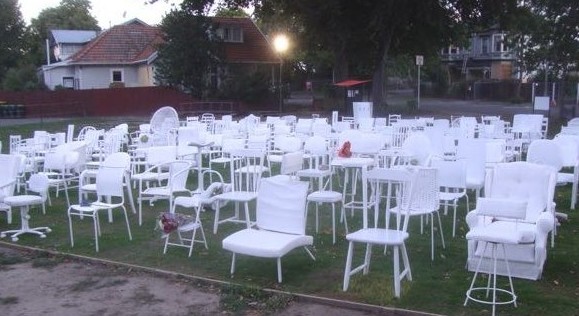 An empty chair is a powerful symbol of loss and can really facilitate our grieving. Creating a prayer station composed only of empty chairs or having empty chairs at the front of the sanctuary are both simple but powerful worship tools. If you have a small group of participants you might like to suggest each person grabs one of the empty chairs and sits it next to them at one point in the service. The image above is from a memorial service Peter Majendie constructed following the Christchurch earthquake of 2011 – heart rending and effective.
An empty chair is a powerful symbol of loss and can really facilitate our grieving. Creating a prayer station composed only of empty chairs or having empty chairs at the front of the sanctuary are both simple but powerful worship tools. If you have a small group of participants you might like to suggest each person grabs one of the empty chairs and sits it next to them at one point in the service. The image above is from a memorial service Peter Majendie constructed following the Christchurch earthquake of 2011 – heart rending and effective.
Use Lots of Candles
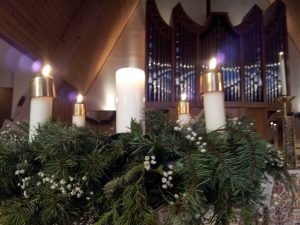
Four candles are often lit in Blue Christmas ceremonies: 1) One candle is lit for those who have passed, giving thanks to the memory that connects them to us this season; 2) One candle is lit to redeem the pain of the loss; 3) One candle is lit to honor ourselves; and, 4) One candle is lit for the gift of faith and hope symbolized in the Christmas story. However the lighting of candles by each of the congregation and the creating of a prayer table for all those we have lost can provide an even more compelling statement.
Create a Collage
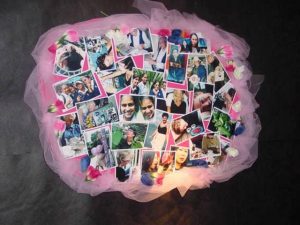
Ask people attending the service to bring photos of those people or situations for which they are grieving. At one of the tables have a large sheet of cardboard on which people can paste their photos to create a collage.
Remember
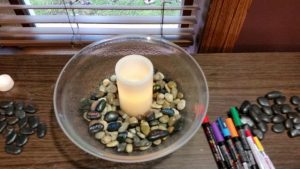 Provide ribbon or paper for people to write names or prayers on. Our church does this for All Saints Day and the ribbon then hangs in the sanctuary until Advent begins. If you have an artist in your congregation who can create a collage from these ribbons and prayers. In the photo above we used small rocks instead, writing peoples’ names on them and then putting them in the bowl around the candle. At the end of the service people took out their stones to take home.
Provide ribbon or paper for people to write names or prayers on. Our church does this for All Saints Day and the ribbon then hangs in the sanctuary until Advent begins. If you have an artist in your congregation who can create a collage from these ribbons and prayers. In the photo above we used small rocks instead, writing peoples’ names on them and then putting them in the bowl around the candle. At the end of the service people took out their stones to take home.
Symbols of Pain and Suffering
 Our good friend Mark Pierson is one of the most creative worship curators I know. I still remember him using zip ties and barbed wire crosses in a worship service that had all of us grieving for the abandoned and despised in our world.
Our good friend Mark Pierson is one of the most creative worship curators I know. I still remember him using zip ties and barbed wire crosses in a worship service that had all of us grieving for the abandoned and despised in our world.
Zip or cable ties, are used as handcuffs in many parts of the world and can effectively be used as symbols of bondage either in our own lives or in the lives of the suffering people around the world that we identify with.
One possibility is to give each person a zip tie at the beginning of the service. After a period of quiet prayer and reflection encourage them to come to the front where a chain link fence or screen has been set up. Participants attach their cable tie to the fence as a symbol of identification of the suffering of people unjustly treated, or senselessly killed around the world. They then pick up a barbed wire cut off cross to take back to their seat as a reminder that Jesus accepted us and came to earth to relieve our suffering and pain. The barbed wire is also a symbol of our willingness to accept responsibility of the suffering of others and to do what we can to alleviate it.
Symbols of Hope
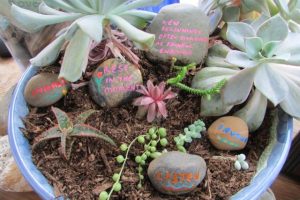 Most people do not want to leave a service with a feeling of despair or hopelessness. Providing a table at which they can create a memorial for the season that gives them hope is one way to turn hopelessness into hope. You might like to provide paper and pencils for people to draw or doodle with, rocks for them to paint or plants to create gardens. Alternatively ask them to bring journals and photos to the event. Provide a table at which they can create artistic images of their loved ones or of the situations they are grieving.
Most people do not want to leave a service with a feeling of despair or hopelessness. Providing a table at which they can create a memorial for the season that gives them hope is one way to turn hopelessness into hope. You might like to provide paper and pencils for people to draw or doodle with, rocks for them to paint or plants to create gardens. Alternatively ask them to bring journals and photos to the event. Provide a table at which they can create artistic images of their loved ones or of the situations they are grieving.
Art journalling like this is becoming more and more popular. Creating pages with the images of those we love who have passed away, decorating them and using them as a focus for prayer during the season can be very healing. Personally, I am discovering more each year how healing a memorial garden or stone can be too and offering this creative exercise to others is something that I increasingly do at retreats and other events.
Resources for Blue Christmas
Services
- Fidelia Magazine has an excellent liturgy for a Blue Christmas service – When Christmas Hurts.
- re:Worship always has great resources and I think has the best list for Blue Christmas ideas of any site I have visited.
Music
- Lectionary Songs has some excellent suggestions on songs for such a service.
- And another good list of Songs of Lament to consider.
- Our church’s Longest Night service used the words of Mumford and Sons song “After the Storm” for the prayer after communion, which I thought was very powerful.
After the Storm
And after the storm,
I run and run as the rains come
And I look up, I look up,
on my knees and out of luck,
I look up.
Night has always pushed up day
You must know life to see decay
But I won’t rot, I won’t rot
Not this mind and not this heart,
I won’t rot.
for those who hate their thighs and for those who have been abused.
for the bones that break and the cancer that spreads.
for blisters and splinters and hairs that split.
for asthma that seizes and for those we love who never get better.
for those who can’t get warm enough to sleep.
for those who wake early to find the dreams of beauty are not real.
for those whose coffee pots break when they need it most.
for hangovers and regrets and nights spent tossing.
Come and lament with me.
Let us attend.
For today and most days
All we bring are broken things.
- Here is a beautiful adaptation of Psalm 88 that would also make a good addition to a Blue Christmas service
Prayers
A couple of years ago, when grieving the still raw death of my mother, I wrote my own Blue Christmas poem.
On this long dark night we await the coming of Christ.
We long for the light of his presence,
With us and in us.
When our souls are deeply troubled,
and our hearts break with the weight of sorrow,
may our grief be seasoned with love,
and our sorrow be buoyed by hope.
In our times of God-forsakenness and estrangement,
May we gaze on the innocent One,
made perfect through suffering.
and see in him our vulnerable God,
who saves in weakness and pain.
May our suffering empty us of pride,
and lead us to true joy
our only security,
in Christ the infinite depths of God’s grace.
Let me end with this meaningful prayer by Ted Loder which appears in Guerrillas of Grace,
O God of all seasons and senses,
grant us the sense of your timing
to submit gracefully and rejoice quietly in the turn of the seasons.
In this season of short days and long nights,
of grey and white and cold,
teach us the lessons of endings;
children growing, friends leaving, loved ones dying,
grieving over,
grudges over,
blaming over,
excuses over.
O God, grant us a sense of your timing.
In this season of short days and long nights,
of grey and white and cold,
teach us the lessons of beginnings;
that such waitings and endings may be the starting place,
a planting of seeds which bring to birth what is ready to be born—
something right and just and different,
a new song, a deeper relationship, a fuller love—
in the fullness of your time.
O God, grant us the sense of your timing.
This is part of a series on Christmas/Advent resources.
- Advent Activities for Families and Kids
- Helping Kids Give Back This Christmas
- Celebrate With Simplicity This Christmas
- Advent/Christmas Music from a Rich Array of Traditions
- Getting Ready for Advent/Christmas Worship Resources for the Season
- Choosing Your Scripture Readings for the Coming Year
- Who Will You Invite to the Manger?
- Advent Candle Light Liturgy
- What On Earth Are The O Antiphons
Resources from Godspace for Advent and Christmas
Godspace has a variety of resources available for celebrating this season.
- NEW DEVOTIONAL! Lean Towards the Light this Advent & Christmas + Advent Cards Bundle compiled by Christine Sine and Lisa DeRosa
- A Journey Toward Home: Soul Travel For Advent to Lent compiled by Kristin Carroccino and Christine Sine
- Waiting for the Light: An Advent Devotional compiled by Ricci Kilmer, Susan Wade and Christine Sine
- Prayer Cards – more than Christmas gifts. These have been used for daily devotions, grief counselling, small groups and congregational prayers.
Check out the entire resource list here for more ideas for Advent and Christmas.
Godspace has a number of Advent resources available for both free download and purchase. Visit our store here.

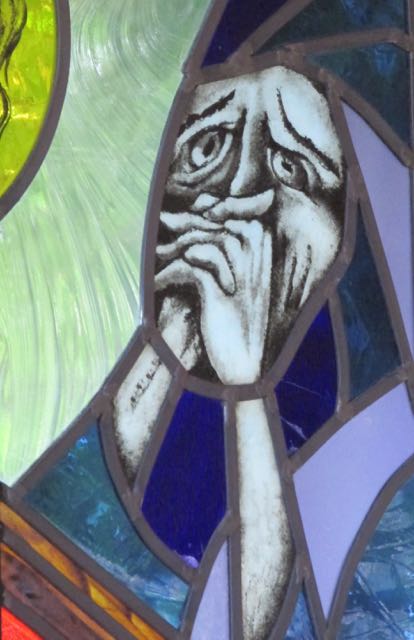
1 comment
I’ve just written a Blue Christmas hymn that is available for free use, called “When Christmas Brings More Pain than Joy.” I have a score and should have a recording soon. Please contact if interested: amanda@amandaudiskessler.com (I’m a published hymnwriter with a website of 80 hymns, worship songs, and rounds). All peace, Amanda Udis-Kessler